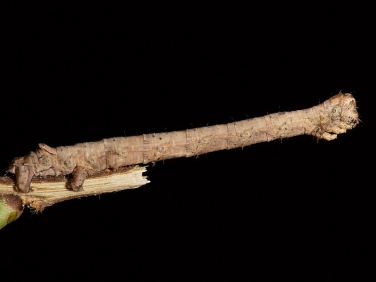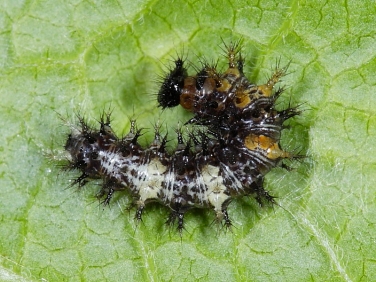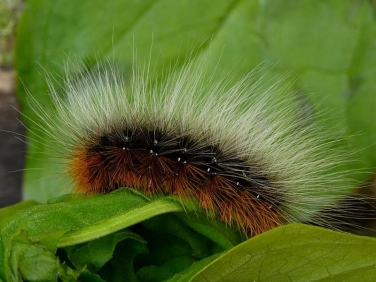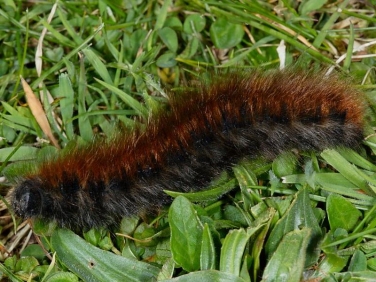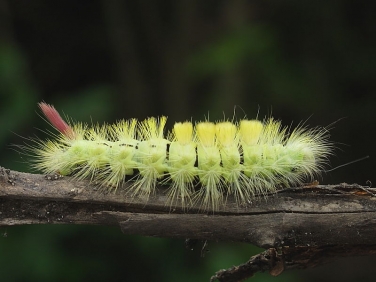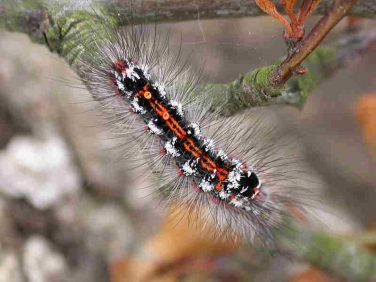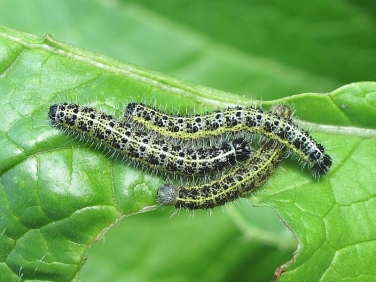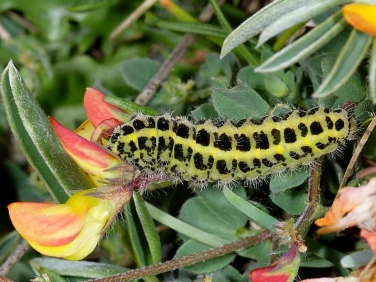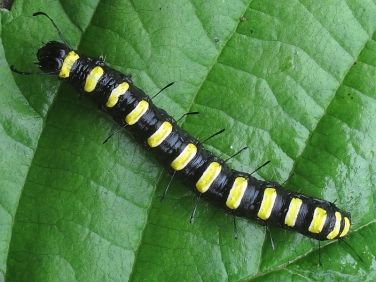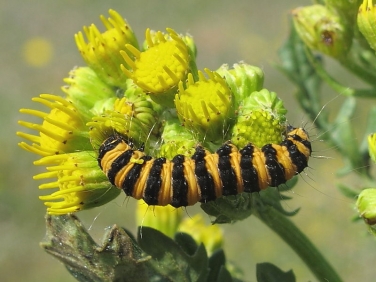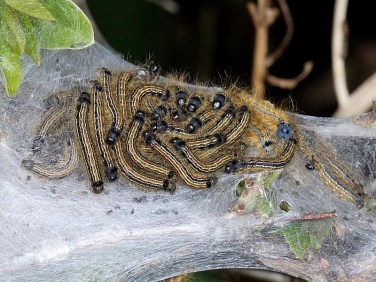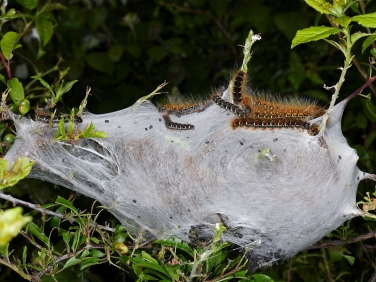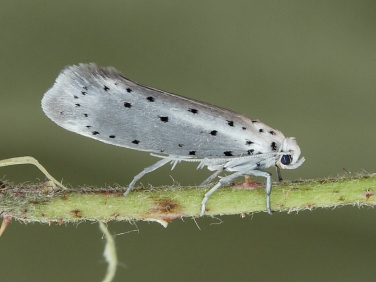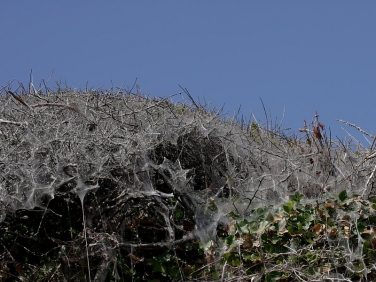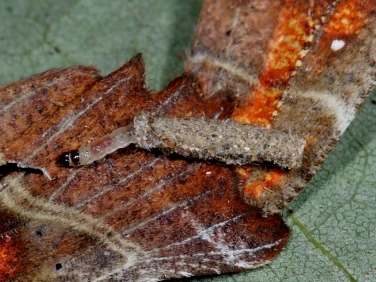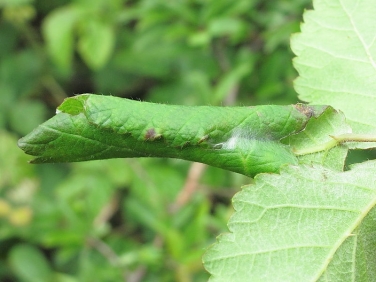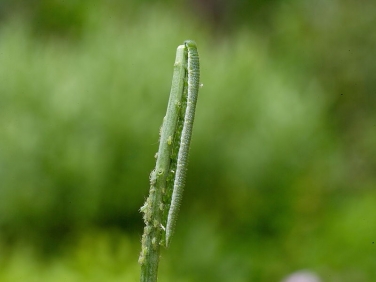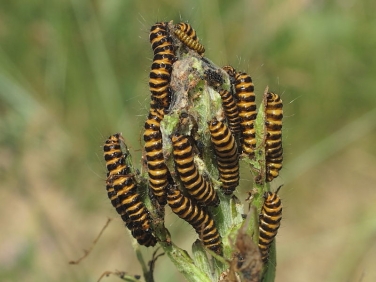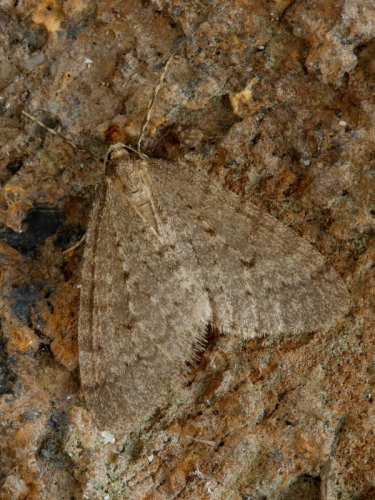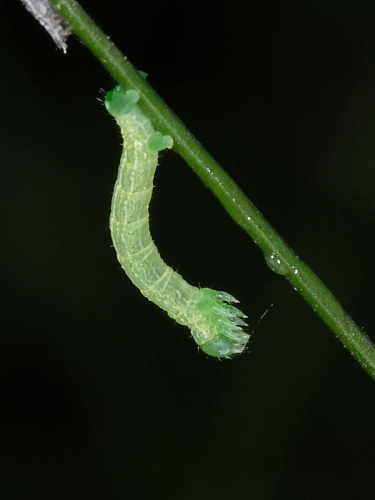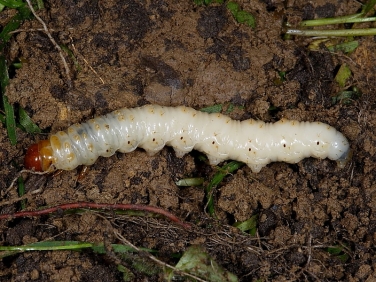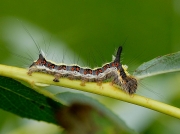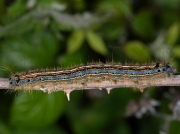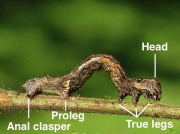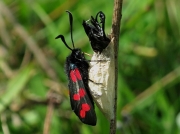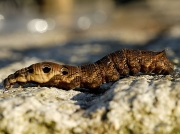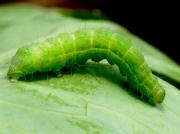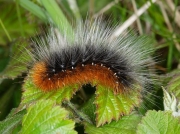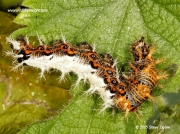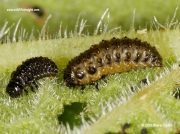Camouflage
Why are caterpillars so difficult to find?
As the most important part of a caterpillars defence against predators is not to be seen, many are the same shape and colour as the twigs and leaves around them. In order not to give themselves away many will remain motionless and hide during the day, only coming out to feed at night. Others resemble bird droppings such as the Comma (Polygonia c-album) butterfly caterpillar (above right).
Unpalatable or poisonous
Why are caterpillars hairy?
Caterpillars may be covered in varying amounts of hair known as setae. Although many species rely on camouflage as a form of protection against predators and have few obvious hairs other species are excessively hairy. This hair acts as a defence against birds and predatory insects such as parasitoid wasps which find it difficult to penetrate beyond the hairs to lay eggs beneath the caterpillar’s skin.
It is notable that some of the hairiest caterpillars are those most often seen basking out in the open such as the Garden Tiger (Arctia caja) (above left) and Fox Moth (Macrothylacia rubi) (above right) indicating that birds find their hairy bodies unpalatable.
Are caterpillars poisonous? Are caterpillar hairs dangerous? Is that tail-spike poisonous?
We are fortunate in Britain that there do not appear to be any caterpillars that can cause any fatal reactions to humans coming into direct contact with them as in some tropical rainforests. Nevertheless, handling caterpillars should be kept to the minimum both for the benefit of the creature and the handler.
The tail-spurs on some British caterpillars such as Hawk-moths may appear threatening to predators but in reality they are harmless. However, the hairs of some caterpillars such as the Pale Tussock Moth (Calliteara pudibunda) (above left) and the Brown-tail Moth (Euproctis chrysorrhoea) can be extremely irritating and when plagues of Brown-tail caterpillars occur pest control measures may be undertaken by public authorities concerned for public safety. The similar Yellow-tail Moth is shown above with the Brown-tail having brown hair tufts, less obvious red lines down its back and two more prominent red spots on the lower body segments. See Brown-tail identification request
Dangerous Caterpillars
In recent years the Oak Processionary Moth, (Thaumetopoea processionea), has established small colonies in parts of the south east of England, notably in some London boroughs.
The caterpillars of this species are not just pests of oak trees but the hairs can be a severe health risk.
Why don’t birds eat Cabbage White caterpillars? Why don’t some caterpillars get eaten by birds?
Some caterpillars are distasteful and poisonous to predators such as birds. These caterpillars obtain their poison by the internal processing of their plant food. The caterpillars of The Large White Butterfly, also known as The Cabbage White, feed on brassica plants containing mustard oils and can store them in their bodies making them distasteful to birds. To vegetable growers the caterpillars of the Large White are one of several vegetable pest species and large numbers can often be seen lying on top of cabbage leaves in full view of birds and yet remain uneaten.
The Five-spot Burnet (Zygaena trifolii) and Six-spot Burnet (Zygaena filipendulae) moths (above right) obtain cyanide from their primary food plant, Common Bird’s-foot-trefoil (Lotus corniculatus), which is poisoinous to predators.
Why are some caterpillars so brightly coloured?
It is thought that the bold colours on some caterpillars are soon recognised by birds as a warning that they are either distasteful or poisonous.
Protective silk webs
What are these silk webs in hegerows and covering trees?
Another form of defence for caterpillars, particularly when small, are silk webs that they spin and live in as a community. The web of The Lackey Moth caterpillar (Lotus corniculatus) moth (above left) is one of the most common to see amongst hedgerows during May. The web is surprisingly tough and strong enough to deter most birds and parasitoid wasps. Hundreds of caterpillars may live together until they outgrow their home and disperse into the surrounding hedgerows where there is less competition for food and plenty of places to pupate. The Small Eggar (Eriogaster lanestris) moth (above right) uses the same strategy.
Some tiny micro moths such as the Orchard Ermine (Yponomeuta padella) (above left) may cover whole trees and hedgerows in silken webs.
Protective cases
Are these tiny snails? Do they have protective cases? What’s inside this rolled leaf?
Many tiny moths spin protective cases useing plant material. The caterpillars of the Psychidae family of micro moths are often referred to as bag worms or case bearers because of their portable cases made out of plant material.
A sub family of tiny Tortrix moths are known as leaf rollers because their caterpillar rolls up leaves and secures them with spun silk forming a protective shelter.
Some of the Tineade species, often known as clothes moths, weave cases out of fibrous material.
Cannibalism
Do caterpillars eat other caterpillars?
Whereas some caterpillars find safety in numbers other species are not so gregarious and are even cannibalistic. The caterpillars of the Orange-tip (Anthocharis cardamines) butterfly that feed primarily on Cuckooflower (Cardamine pratensis) and The Cinnabar (Tyria jacobaeae) moth that feed on Ragwort are cannibalistic.
Caterpillars of these species are often found on isolated food plants which can soon become stripped bare of leaves resulting in starvation unless the caterpillars can find another food source close by. As well as preserving the remaining food for the surviving caterpillar this cannibalistic survival strategy may also provide a readily processed and highly nutritious meal for minimal effort.
Finding food sources
What is ballooning?
Some UK caterpillars hang from a silken thread from which they can be blown by the wind into a neighbouring tree. This is known as ballooning and enables a caterpillar to reach fresh food sources. The Winter Moth (shown above as an adult left and larva right) larvae are exponents of this technique and, although not without its risks, can enhance their survival chances by carrying them to fresh buds or new growth.
Going underground
Do caterpillars live underground?
Many caterpillars are almost hairless and live underground feeding on the roots of a wide variety of plants.Living underground they are safe from many predators but are seen as pests by farmers and pesticides are used to eradicate them.
The caterpillars of many species of moth spend most of their life growing and feeding on plants above ground but pupate in leaf litter or just beneath the surface of the soil. See more on pupation.
PLEASE NOTE - we have closed comments due to excess spam but are still identifying many caterpillar queries sent by email to Steve - wildlifeinsight@gmail.com - see our page on help with caterpillar identification for more information.
